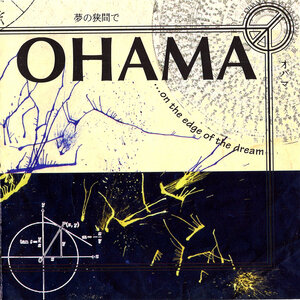Information/Write-up
Released Nov 4, 1994, On the Edge of the Dream marks one of the most ambitious and vulnerable works in Tona Walt Ohama’s catalogue — a 60-minute album created as the soundtrack for his multimedia performances at the Calgary Planetarium. Conceived during a tumultuous personal period, the album emerged after Ohama was denied visitation with his newborn son, a turning point that led him back into sustained music-making. The result is a deeply atmospheric cycle of electronic pieces shaped by grief, resolve, and the desire to build an inner world when the outer one had closed its doors.
The opening track features tribal-inflected percussion inspired by Peter Gabriel’s “Rhythm of the Heat,” signaling a shift away from the synth-pop structures of his 1980s work. The album threads through ambient textures, spoken fragments, rhythmic pulses, and dreamlike transitions; one piece incorporates the sound of a crying infant, while others drift toward meditative electronics anchored by the repeated lyric: “You can be whatever you believe… You can be whatever that you dream.”
Developed using early digital-video and CD-ROM tools — inspired by Myst and Peter Gabriel’s Secret World Xplora1 — the project pushed mid-1990s Macintosh hardware to its limits. Ohama’s integration of moving images, QuickTime video, and synchronized sound led to a two-part profile in EQ Magazine, highlighting the technical experimentation behind the work. Live performances at the Calgary Planetarium used multiple projectors and immersive audio, but promotion restrictions imposed by the City of Calgary left the production largely unseen; across ten nights, attendance totaled only 500 people. The experience was creatively fulfilling but personally devastating, and Ohama has often described the project as a turning point — both artistically and emotionally.
Originally released in a limited edition of 256 copies, the CD featured a silkscreened jewel case, a 12-page colour booklet, a personalized Go-Card postcard, two signed art cards, a numbered registration card, and a numbered puzzle piece. A standard non-limited version was later issued in a plain jewel case.
Despite its quiet release, On the Edge of the Dream remains one of Ohama’s most introspective works — a document of transition, resilience, and a rare moment where sound, personal history, and early digital art converged.
“I realized, okay — he’s not going to be in my life. I’m going to work on music again. And that’s how this came about. It’s a very special album.” — Ohama
-Robert Williston
• custom silkscreened jewel case
• 12-page full-colour booklet
• personalized Go-Card postcard
• numbered registration card
• numbered puzzle piece
• 2 signed art cards
• CD imprint reads “Limited Edition of 256 copies"
Liner notes:
I’d always dreamed of performing at the Calgary Planetarium because Robert Fripp had performed there in 1979.
Fripp had quit King Crimson and played small venues to counter what he called “the trend to idiocy in rock performance, characterized by the escalation in the size of rock events and the general acceptance of rock music as a spectator sport.” I was in awe of Robert Fripp.
In 1994 my dream came true.
“On The Edge Of The Dream” was created using the latest cutting-edge bleeding-edge tech inspired by Cyan’s Myst and Peter Gabriel’s Secret World Xplora1 CD-ROM.
Digital video was still in its infancy. Apple QuickTime was the first time any of us had seen video recorded and played back on a personal computer. That was one of those jaw-dropping moments where the world did a seismic shift. People today would laugh that this “mind-blowing” video was 320 x 240 pixels but I really wasn’t the same person after this happened.
Edge Of the Dream truly pushed the Apple Macintosh (and me) to the very limits of possibility and as a result I was given a two issue feature “Multimedia in the Real World” in EQ Magazine. (link www.facebook.com/photo/?fbid=1095401588823014&set=pcb.1095401682156338)
It looks so archaic and dated and yes, my hair was down to my waist in 1994 and I’m even a little embarrassed to be associated with the word “multimedia” today but…I think the music itself still stands.
I was a dreamer who had nightmares…
This show was an unqualified failure, at least from a financial point of view.
Why? It wasn’t just the expense of using the very latest technology. It wasn’t just playing synth music in the era of Nirvana and ‘unplugged’. I learned (far too late) that the Alberta Science Centre Planetarium was run by the City of Calgary.
That meant I was forbidden to advertise the show unless the City approved every bit of content. Without that approval I couldn’t even hang a poster in the lobby and there was no way the Planetarium would announce the show on the large scrolling outdoor marquee. This was a devastating blow.
There was no internet in 1994 to spread the word. Correction, the internet existed but it really wasn’t a thing yet. In fact the first widely adopted consumer web browser, Netscape Navigator, came out at the very end of 1994.
The old Alberta Science Centre Planetarium seated 350. One night I performed to 3 people. Over 10 nights our total attendance was only 500. Don’t get me wrong, I have no regrets about doing this project. But it broke me. I really wasn’t the same person after this happened.
Hard to believe that the album is over 30 years old. Please listen to On Edge Of The Dream as it was intended (as an album - from start to finish) and, as the Beatles said, “turn off your mind, relax and float downstream.”


No Comments